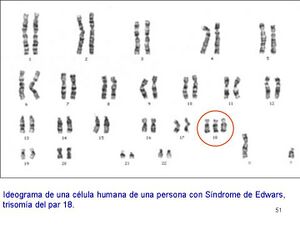Edward's Syndrome (Trisomy 18)
Definition[edit | edit source]
Edward's Syndrome, also known as Trisomy 18, is a rare genetic condition caused by a triplication of the 18th chromosome. The additional chromosome causes a complex congenital malformation syndrome predominantly affecting inner organs, overall growth and anatomical anomalies. Most babies which carry the disease die either before birth or within the first days of their life, only around 13 out of 100 survive their first birthday.[1] Very few children survive longer than five years, and in those cases are severely impaired in their cognitive function and intellectual abilities.
Types of Edward's Syndrome[1]
- Full Edward's Syndrome (Three complete sets of the 18th chromosome): Most severe type of the disease, highest mortality rate.
- Mosaic Edward's Syndrome (Trisomy only appears in some cells): Severity of the condition depends on the number and types of affected cells, some children may live to adulthood.
- Partial Edward's Syndrome (Partial trisomy 18, only sections of the 18th chromosome are tripled): Severity of the condition depends on which section of the 18th chromosome is tripled.
Prevalence[edit | edit source]
Around 1/5,000 - 1/6,000 children which are born alive have Edward's Syndrome.[2][3] Sadly, most babies carrying the Full Edward's Syndrome die before birth. Prevalences are lower for the types of Mosaic Edward's Syndrome (1/20) and Partial Edward's Syndrome (1/100) out of all children born with Edward's Syndrome.[1] The male-female ratio is 1:3.[3]
Etiology[edit | edit source]
The additional chromosome is most commonly not inherited, but an effect of spontaneous malformation during cell division.[4] In few cases of inheritance from the mother's side, mostly happening in Partial Edward's Syndrome.
Characteristics / Clinical Presentation[edit | edit source]
There are no specific criteria for clinically diagnosing children with Trisomy 18 since presentation can vary drastically, depending on the severity of the condition. Typical symptoms however include
- Low birth weight and small body
- Little intrauterine movement of the fetus
- Abnormalities of body shape (especially microcephaly, prolonged back of the head, short sternum)
- Organ deformities and malfunctions
- Fisted fingers, crossed fingers (thumb and small fingers cross other fingers)
- Rocker bottom feet or club feet
Diagnostics[edit | edit source]
Blood testing and ultrasound screening is used to diagnose Edward's Syndrome during 10th and 14th week of pregnancy. The screening is mostly paired with a screening for Down Syndrome and Patau's Syndrome.[1]If an increased risk of Edward's Syndrome is presented, invasive testing will be offered either through chorionic villus sampling (analysing placenta cells) or amneocentesis (sampling the amniotic fluid). Invasive tests increase the risk of miscarriage and need to be thoroughly discussed with the parents. To diagnose Edward's Syndrome after birth, a blood sample will be taken and genetically analysed.
Medical Management[edit | edit source]
There is no cure for Trisomy 18 and treatment options depend on the severity of the condition. Therapy and medical management will mostly focus on supporting the family and the babies' acute impairments.
References[edit | edit source]
- ↑ 1.0 1.1 1.2 1.3 National Health Service, Edward's syndrome (trisomy 18), Sept 2020, Available from: https://www.nhs.uk/conditions/edwards-syndrome/, [last accessed 12 March 2022].
- ↑ DocCheck Flexikon, Edwards Syndrom, 18. April 2011, Available from: https://flexikon.doccheck.com/de/Edwards-Syndrom [last accessed 12 March 2022].
- ↑ 3.0 3.1 MSD Manuals, Trisomie 18, Okt 2018, Availabe from: https://www.msdmanuals.com/de-de/profi/p%C3%A4diatrie/chromosomen-und-genanomalien/trisomie-18 [last accessed 12 March 2022].
- ↑ Medline Plus - National Library of Medicine (NIH), Trisomy 18, Feb 2021, Available from: https://medlineplus.gov/genetics/condition/trisomy-18/#inheritance [last accessed 12 March 2022].







